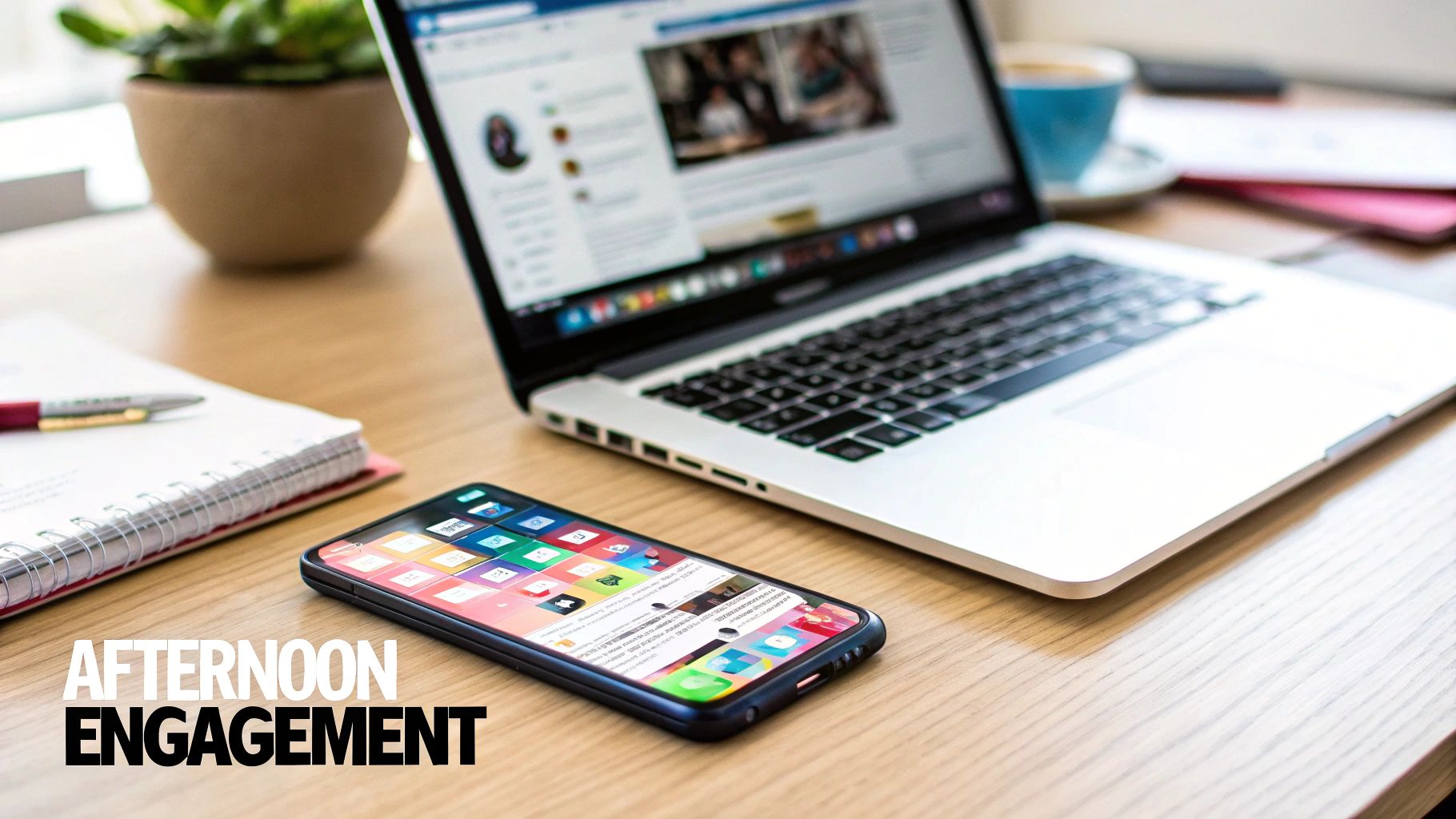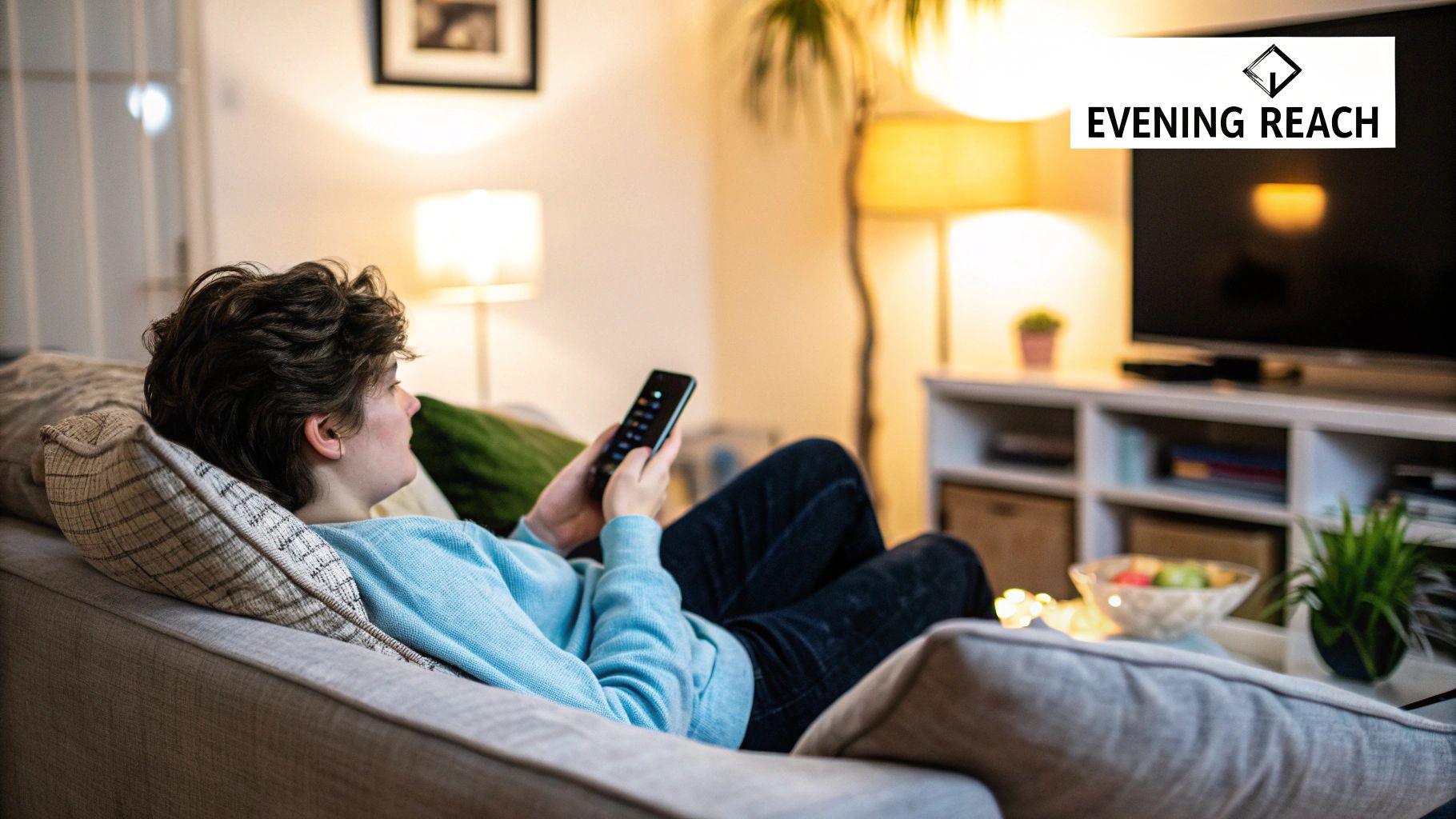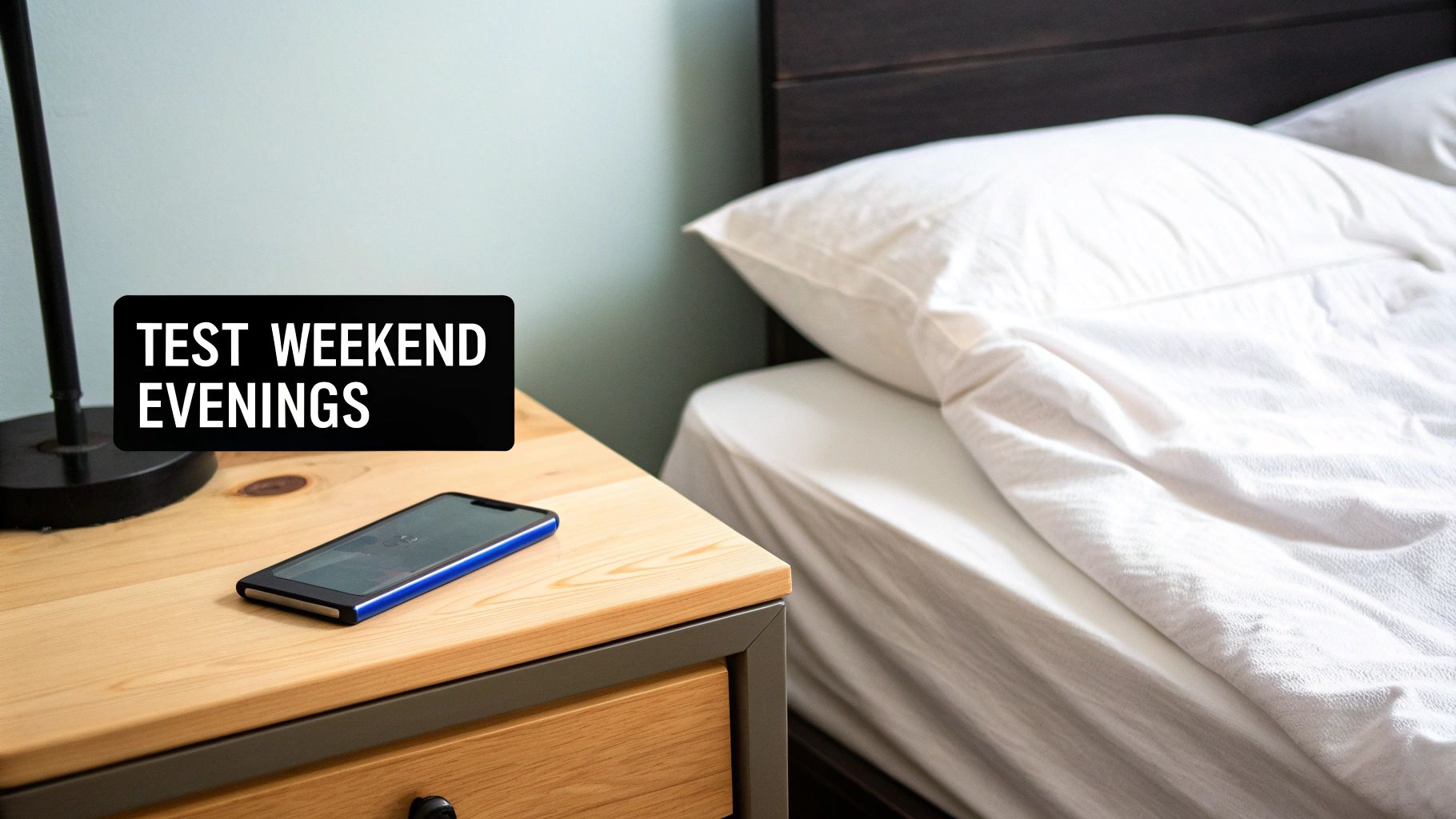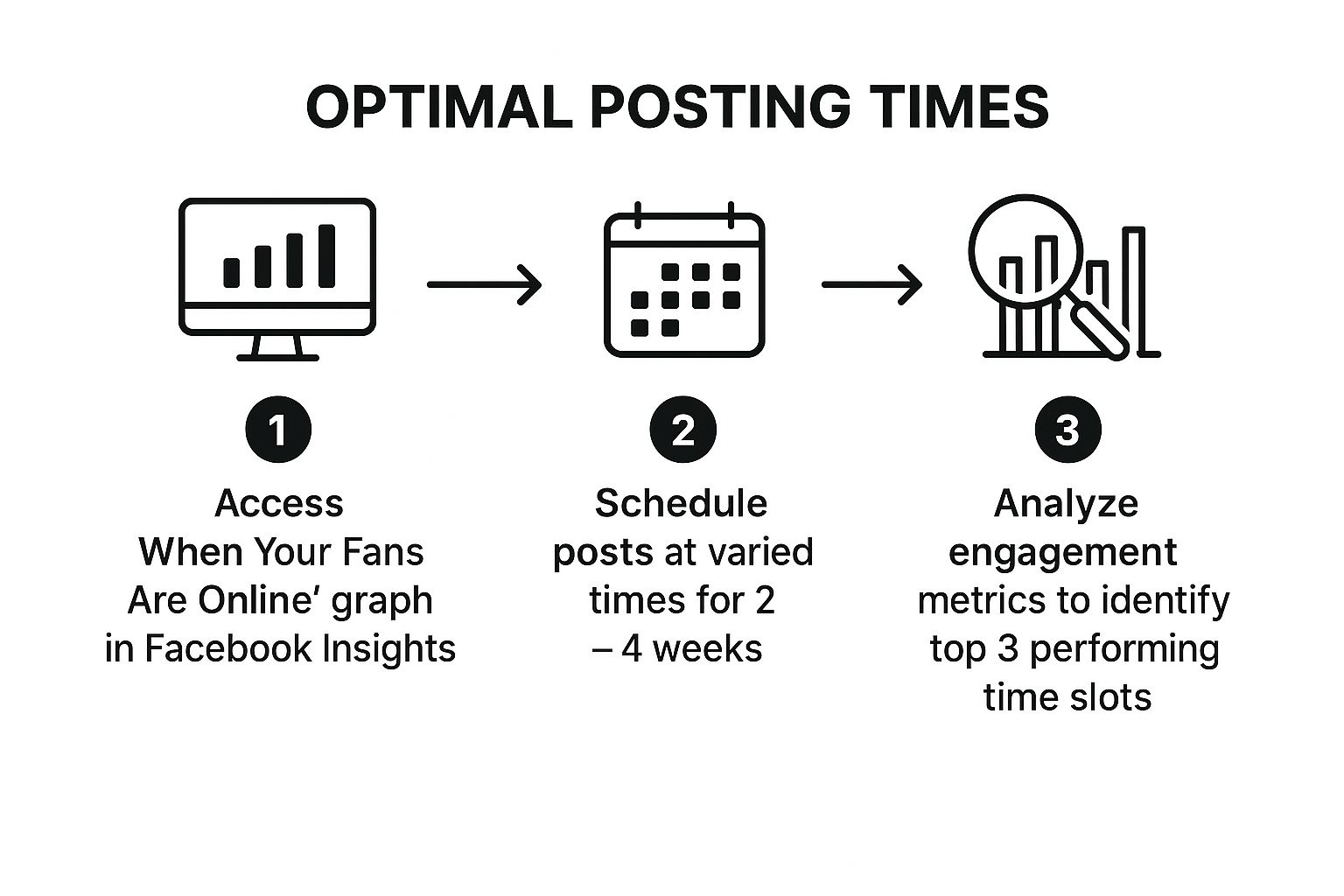It's the question every social media manager asks: What is the best time of day to post to Facebook? In a world of shifting algorithms and crowded news feeds, timing isn't just a detail; it's a critical component of your content strategy. While a one-size-fits-all answer doesn't exist, vast amounts of data reveal powerful patterns about user behavior. Posting at 2 PM versus 9 AM can mean the difference between viral engagement and content that disappears without a trace.
This guide cuts through the noise to provide a data-backed roadmap for maximizing your reach. We'll explore the six most effective posting windows, supported by industry research, and show you precisely how to tailor this knowledge to your unique audience and brand goals. To truly unlock your perfect Facebook posting schedule, it's beneficial to view it within the broader context of effective social media management strategies.
Forget guesswork and generic advice. It's time to leverage strategic timing to ensure your message reaches the right people when they're most receptive and ready to engage. This list will give you the actionable insights needed to move beyond the clock and build a posting schedule that drives real results.
1. Post Between 1-4 PM for Peak Engagement
Across numerous studies and industries, the early to mid-afternoon window of 1 PM to 4 PM consistently emerges as a powerhouse for Facebook engagement. This timeframe strategically captures users during natural breaks in their day, such as post-lunch scrolls, afternoon work lulls, and the moments before they transition into evening routines. This convergence of user availability makes it a prime candidate for the best time of day to post to Facebook if you're aiming for maximum immediate interaction.

The logic behind this peak period is rooted in typical daily schedules. By 1 PM, the morning rush has subsided, and people often turn to social media for a mental break. This period avoids the content saturation of the morning and catches users before the evening commute and family time begin, leading to higher rates of likes, comments, and shares.
Real-World Examples of Afternoon Success
The effectiveness of this afternoon window isn't just theoretical; it's backed by tangible results from diverse brands.
- B2B Performance: Hootsuite, a leader in social media management, discovered their B2B-focused content performed 32% better when posted around 2 PM compared to morning slots. This highlights that even professional audiences are more receptive during afternoon work breaks.
- Viral Content: BuzzFeed, known for its highly shareable quizzes and lifestyle articles, sees its engagement consistently spike between 1 PM and 3 PM EST. This window perfectly aligns with audiences seeking lighthearted content to break up the workday.
- Local Business Growth: A case study involving a local restaurant showed a 45% increase in post reach simply by shifting their daily specials posts from 10 AM to 2 PM. This change captured the "what's for dinner?" planning crowd more effectively.
How to Implement This Strategy
To leverage the 1-4 PM window, focus on precision and audience awareness. Blindly posting at 2 PM isn't enough; you need a strategic approach.
- Verify with Your Data: Use Facebook Insights to confirm when your specific audience is most active. Navigate to the "Audience" tab to see a chart of the days and times your followers are online. This data will help you pinpoint the most potent hour within the 1-4 PM range for your page.
- Account for Time Zones: If your audience is geographically diverse, segment your scheduling. Post key content based on the afternoon peak in your most important time zones. A tool like EvergreenFeed can automate this process, ensuring your posts go live at the optimal local time for different audience segments.
- Test and Refine: Don't just pick a time and stick to it. Test posting at 1 PM, 2 PM, and 3 PM on different days over a two-week period. Analyze which specific time slot generates the best engagement for your content type and refine your schedule accordingly.
2. Leverage Weekday Mornings (9-11 AM) for Professional Content
While the afternoon is a general engagement hotspot, the weekday morning window from 9 AM to 11 AM offers a unique, strategic advantage for specific types of content. This period captures users as they begin their workday, often scrolling through their feeds with a morning coffee or during their first break. Targeting this timeframe is a powerful way to find the best time of day to post to Facebook for professional, educational, and B2B content.
The psychology behind this time slot is based on user mindset. In the morning, people are often in a productive, "get things done" mode. They are more receptive to content that offers value, industry insights, or professional development. This contrasts with the afternoon, when users may be seeking lighter, more entertaining content.
Real-World Examples of Morning Success
The effectiveness of the 9-11 AM window is well-documented, especially for brands focusing on a professional audience.
- B2B Education: HubSpot, a giant in the marketing software space, has noted that their educational blog posts and marketing guides perform best around 10 AM on weekdays. This timing aligns perfectly with their target audience of marketers looking for fresh ideas to start their day.
- Professional Engagement: Studies show that LinkedIn-style professional content shared on Facebook can see up to 28% higher engagement when posted in these morning slots. This is because users are more likely to be in a career-oriented headspace.
- Financial Sector Conversions: Several financial services companies report that their posts announcing webinars or new investment reports generate the highest click-through and conversion rates between 9 AM and 10 AM, capturing clients before the day's meetings take over.
How to Implement This Strategy
To capitalize on the morning productivity mindset, your approach must be targeted and value-driven. Simply posting any content at 10 AM won't guarantee success.
- Align Content with Mindset: Use this window specifically for webinar announcements, industry news, in-depth articles, how-to guides, and company updates. Save your more casual or entertaining content for the afternoon peak.
- Keep It Concise but Valuable: Morning scrollers are often multitasking. Ensure your posts are easy to digest quickly but offer substantial value. Use strong visuals and clear, bold headlines to grab attention instantly.
- Include a Clear Call-to-Action (CTA): Leverage the "action mode" of your audience. Include direct CTAs like "Register for our webinar," "Download the report," or "Read the full article now" to capitalize on their productive mindset.
- Pinpoint Your Prime Morning: The 9-11 AM window is a general guide. Use your Facebook Insights to determine if your audience is more active at 9:30 AM versus 10:30 AM. A/B test posts across this two-hour block to find the sweet spot for your specific followers.
3. Target Evenings (7-9 PM) for Maximum Reach and Viral Potential
As the workday concludes and users settle in at home, the evening hours of 7 PM to 9 PM emerge as Facebook's highest traffic period. This window captures a massive, relaxed audience engaged in leisure browsing, making it a golden opportunity for content designed to entertain, inspire, and go viral. If your goal is to achieve the largest possible audience size, this timeframe is a strong contender for the best time of day to post to Facebook, though it comes with increased competition.

The logic behind this evening peak is straightforward: people have finished dinner, household chores are often done, and they turn to their personal devices for entertainment and social connection. This relaxed state of mind makes them more receptive to longer-form content like videos and more likely to share posts that evoke strong emotions.
Real-World Examples of Evening Success
The power of the evening slot is most evident with content that connects on a personal or emotional level.
- Viral Media: National Geographic's stunning wildlife videos consistently achieve 3x more engagement when posted around 8 PM. This timing taps into an audience ready to be captivated by high-quality, visually-driven storytelling.
- Food & Recipe Content: Tasty, a food-focused media giant, optimizes its video releases for the 7-8 PM window. This strategy results in an average of 15,000+ shares per video as they catch users who are either relaxing after dinner or planning future meals.
- E-commerce Engagement: A case study on a lifestyle e-commerce brand revealed that product posts published at 8 PM generated 2x more comments than their daytime counterparts. The posts framed products within a relaxing evening context, sparking conversation and desire.
How to Implement This Strategy
To succeed in the crowded evening feed, your content must be exceptional and your approach must be strategic.
- Reserve Your Best Content: The 7-9 PM window is not for everyday updates. Save your highest-quality, most shareable content, such as compelling videos, emotional stories, or major announcements, for this peak time to maximize its impact.
- Focus on Visuals and Emotion: Your content needs to stand out. Use eye-catching videos or striking images to stop the scroll. Craft content that is entertaining, heartwarming, or surprising rather than purely informational or sales-focused.
- Engage Immediately: The first 30-60 minutes after posting are critical. Be present to reply to comments and answer questions as they come in. This immediate engagement signals to the Facebook algorithm that your post is valuable, which can significantly improve your Facebook organic reach.
- Test and Boost: Experiment within the 7-9 PM block to find your specific sweet spot. Post at 7:15 PM, 8:00 PM, and 8:45 PM on different days to see what works best. Consider putting a small ad budget behind your highest-performing evening posts to amplify their reach even further.
4. Capitalize on Wednesday as the Week's Peak Day
While specific times are crucial, the day you post holds equal importance. Across countless studies from industry leaders like Sprout Social and Buffer, Wednesday consistently stands out as the single best day of the week for Facebook engagement. This mid-week peak, often called 'hump day,' represents a psychological sweet spot where users are deeply settled into their work routines but are also actively seeking distractions to get them through the rest of the week. This unique mindset makes them more receptive to content, making Wednesday a key part of finding the best time of day to post to Facebook.
The logic is simple: Monday is for catching up, and by Friday, users are often checked out. Wednesday sits perfectly in the middle, offering a blend of high user activity and a need for a mental break. When you combine this peak day with an optimal time slot, like 1-3 PM, your content has a significantly higher chance of achieving maximum reach and interaction.
Real-World Examples of Wednesday Wins
The power of 'hump day' isn't just a theory; it’s a proven strategy that delivers measurable results across different sectors.
- Retail Engagement: Major fashion retailers have reported that their highest click-through rates on new product posts consistently occur on Wednesdays. This suggests that consumers are more inclined to browse and shop online as a mid-week reward.
- Non-Profit Impact: A study of non-profit organizations revealed a 35% increase in shares for inspirational and cause-related content posted on Wednesdays compared to other weekdays. This day seems to amplify the audience's willingness to engage with and spread meaningful messages.
- Tech Industry Announcements: Tech companies often schedule major product announcements and software updates for Wednesdays. The high engagement ensures the news reaches the widest possible audience, generating immediate buzz and feedback.
How to Implement This Strategy
To effectively harness Wednesday's potential, you need to treat it as the main event in your content calendar.
- Schedule Your Best Content: Reserve your most important, engaging, or high-value content for Wednesday. This could be a major announcement, a viral-worthy video, a detailed guide, or a compelling customer story. Don't waste this prime slot on routine posts.
- Run Mid-Week Promotions: Launch contests, giveaways, or limited-time offers on Wednesdays to capitalize on the heightened audience participation. The sense of a mid-week treat can significantly boost campaign performance.
- Create Themed 'Hump Day' Content: Build audience anticipation by creating a recurring Wednesday content series, like "Wednesday Wisdom" or "Mid-Week Motivation." This trains your followers to look for and engage with your content on this specific day. While this post focuses on Facebook, this is one of many great tips for planning your calendar. Learn more about the best days to post on social media on evergreenfeed.com to round out your strategy.
5. Avoid Weekend Mornings but Test Weekend Evenings
Weekend posting on Facebook demands a completely different strategy than weekday posting. Saturday and Sunday mornings are often engagement dead zones as users sleep in, spend time with family, or are occupied with offline activities. However, weekend evenings, particularly Saturday from 8 PM to 10 PM, can be a goldmine. This shift highlights a different user mindset, one focused on entertainment, inspiration, and personal interests rather than work, making it a critical consideration for finding the best time of day to post to Facebook.

The logic is simple: the weekend audience is relaxed and seeking leisure. Morning hours are for chores, family breakfasts, or outdoor plans. By evening, users are winding down and more receptive to content that aligns with their personal passions, making it a prime time for specific industries to connect with a highly engaged audience.
Real-World Examples of Weekend Evening Success
Brands that tailor their content to this leisurely mindset see significant returns by strategically posting on weekend evenings.
- Travel and Leisure: Travel brands have reported seeing engagement rates jump by as much as 40% on weekend evening posts. Showcasing breathtaking destinations on a Saturday night inspires "getaway" planning when users are most relaxed and aspirational.
- Food and Recipes: Content centered on food and cooking performs exceptionally well between 7 PM and 9 PM on Saturdays. This is when users are either planning their Sunday meals or looking for indulgent recipes to try, leading to higher saves and shares.
- Fitness and Motivation: Fitness influencers often report strong Sunday evening engagement with "Monday motivation" content. This timing perfectly captures audiences who are mentally preparing for the week ahead and are receptive to fitness goals and inspirational messages.
- Entertainment and Events: For entertainment venues and event promoters, posting on a Friday or Saturday evening is key. This is when users are actively looking for weekend plans, making it the ideal time to promote ticket sales and events.
How to Implement This Strategy
To capitalize on weekend evening potential, your content and timing must be perfectly aligned with your audience's relaxed state of mind.
- Analyze Your Niche: If you are a B2B brand, it's often best to skip weekend posting entirely unless you are testing special, non-work-related content. Conversely, B2C brands in lifestyle, entertainment, or food should prioritize this window.
- Shift Your Content Focus: Weekend content should be aspirational, entertaining, or inspirational. Ditch the corporate updates and focus on what resonates with your audience on a personal level.
- Schedule Strategically: Use Saturday evenings for "weekend plans" or "Sunday funday" ideas. Leverage Sunday evenings for "week ahead" planning, motivational posts, or relaxing content. A tool like EvergreenFeed can help you schedule these specialized posts without requiring you to work on the weekend.
- Reduce Post Frequency: Quality trumps quantity on weekends. Instead of multiple posts, focus on one high-impact post during the peak evening hours to avoid overwhelming your audience.
6. Use Facebook Insights and Analytics to Find YOUR Optimal Time
While general best practices offer a solid starting point, the most powerful strategy is to consult your own data. Every audience is unique, and Facebook Insights provides the exact information needed to determine when your specific followers are most active and engaged. Using this native analytics tool ensures that your posting schedule is tailored to your audience's behavior, making it the ultimate method for finding the best time of day to post to Facebook.

This simple process flow visualizes how to move from general data to specific, actionable insights for your page. Following these steps systematically eliminates guesswork and roots your strategy in hard evidence, directly connecting your scheduling efforts to performance outcomes.
The core principle here is that data-driven timing will always outperform generalized advice. A fitness brand targeting early risers will find different peak times than a nightlife promoter targeting a late-night crowd. Relying on your page’s analytics is the only way to uncover these unique, high-impact windows.
Real-World Examples of Data-Driven Success
The impact of using proprietary data is clear across industries, often revealing counter-intuitive but highly effective posting times.
- Beauty Industry: A popular cosmetics brand discovered through its Insights that its audience of young professionals was most active around 9 PM. By shifting its tutorials and product launches to this evening slot, it achieved a 67% increase in engagement compared to its previous afternoon posts.
- Fitness Niche: A local gym found that its posts about class schedules and motivational content performed best at 5:30 AM. This aligned perfectly with the pre-work workout culture of its members, a peak time that general guides would have missed entirely.
- B2B Software: Contrary to the conventional wisdom that Fridays are a dead zone, a B2B software company found its highest click-through rates on Friday afternoons. Their data showed that decision-makers were catching up on industry news before the weekend, creating an unexpected opportunity.
How to Implement This Strategy
Leveraging your own analytics is a straightforward process that requires consistency and careful analysis.
- Access Your Insights: Navigate to your Facebook Page, then go to the "Insights" tab and select "Posts." Here you will find the "When Your Fans Are Online" graph, which shows the days and hours your followers were most active over the past week.
- Conduct Strategic Tests: Use the data from the graph as a starting point. Schedule posts at different peak times over a 4-6 week period to generate enough data for comparison. Don't rely on a single post's performance; look for consistent patterns.
- Analyze and Refine: Export your post-level data to analyze performance metrics like reach, likes, comments, and shares by the time of day they were posted. Identify your top-performing time slots and adjust your schedule accordingly. For a deeper dive, you can organize these findings in a structured way. Learn more about creating a social media analytics report on evergreenfeed.com.
- Segment by Content Type: Remember that different types of content may perform better at different times. Analyze whether your videos, images, and links have unique peak engagement windows and consider segmenting your schedule based on content format.
6-Key Insights on Best Facebook Posting Times
| Strategy | Implementation Complexity 🔄 | Resource Requirements ⚡ | Expected Outcomes 📊 | Ideal Use Cases 💡 | Key Advantages ⭐ |
|---|---|---|---|---|---|
| Post Between 1-4 PM for Peak Engagement | Moderate (consistent testing required) | Moderate (scheduling tools recommended) | High engagement rates across industries | General content, promotions, product launches | Highest average engagement, broad applicability |
| Leverage Weekday Mornings (9-11 AM) | Moderate (requires timing A/B testing) | Low to moderate (content planning) | Quality engagement with professional audience | B2B, educational posts, industry news | Focused, high-quality engagement, less saturated |
| Target Evenings (7-9 PM) for Maximum Reach | High (requires strong content and engagement) | High (quality content + active management) | Maximum reach, viral potential | Entertainment, viral campaigns, video content | Largest active audience, best for sharing |
| Capitalize on Wednesday as the Week's Peak Day | Moderate (scheduling major content) | Moderate (planning around key day) | 15-25% higher engagement vs other days | All content types, product announcements | Statistically highest engagement day |
| Avoid Weekend Mornings but Test Weekend Evenings | Moderate to high (requires niche testing) | Moderate (targeted content creation) | Variable, often lower overall but niche engagement | Lifestyle, entertainment, community engagement | Less competition, deeper engagement opportunities |
| Use Facebook Insights and Analytics | High (analytics learning curve + data tracking) | Low to high depending on tools used | Optimized posting times, improved engagement | Any brand seeking tailored timing | Data-driven, continuously optimized timing |
Turn Insights into Action: Automate Your Perfect Schedule
Mastering the best time of day to post to Facebook is a powerful lever for amplifying your reach, but information without implementation is just noise. Throughout this guide, we've unpacked the data-backed windows of opportunity, from the high-engagement hours of 1-4 PM to the professional focus of weekday mornings. We've seen how different times serve different goals, whether you're aiming for midday clicks or evening viral potential.
The ultimate takeaway is that your optimal schedule is a dynamic blend of general best practices and your own unique audience data. The key is to stop posting randomly and start posting with intention, guided by analytics and a clear strategy.
From Data-Driven to Done
The real challenge isn’t just knowing when to post; it's executing that schedule flawlessly, day in and day out. Manually logging in at 1 PM on a Wednesday or 8 PM on a Thursday is not only inefficient but also unsustainable for busy marketers and business owners. This is where strategic automation transforms your workflow from a chore into a competitive advantage.
By translating your findings into an automated schedule, you ensure every piece of content gets its moment in the spotlight. You reclaim valuable hours that can be reinvested into creating better content, engaging with your community, and analyzing performance-the very activities that drive real growth.
Your Action Plan for Consistent Success
Moving forward, your mission is to turn these insights into a repeatable, automated system. Here are your next steps:
- Audit Your Data: Dive into your Facebook Insights. Cross-reference your top-performing posts with the general time slots we've discussed to identify your personalized "golden hours."
- Segment Your Content: Categorize your posts. Are they educational articles, behind-the-scenes videos, or community questions? Assign each category to the time slot where it's most likely to resonate.
- Build Your Automated Schedule: Use a tool to build a posting calendar based on these content categories and time slots. For example, schedule your professional, thought-leadership content for 9-11 AM on weekdays and your more shareable, entertainment-focused posts for the 7-9 PM window.
Embracing this methodical approach removes the guesswork and stress from your social media management. It ensures that finding the best time of day to post to Facebook isn't a one-time discovery but a continuous, optimized process that consistently delivers results. You're no longer just a content creator; you're a strategic publisher, engineering success with every scheduled post.
Ready to stop guessing and start scheduling with data-driven precision? EvergreenFeed allows you to build a library of your best content, categorize it, and set a perfect, automated schedule based on the optimal times you've just learned. Visit EvergreenFeed to turn these insights into effortless, consistent results and ensure your content always gets the visibility it deserves.




